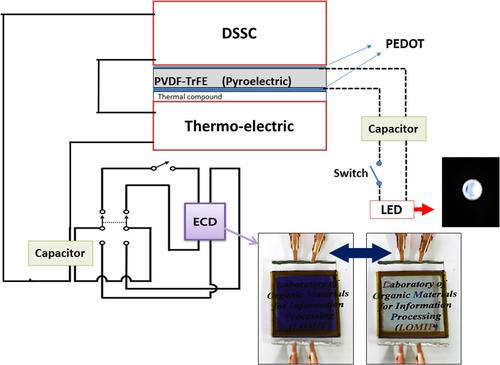Hybrid Energy Harvester Eyed for Solar Cells Captures More of Light Spectrum
Researchers have developed a hybrid energy harvester for generating electricity from multiple spectrums of solar energy.
May 27, 2016
Most solar-energy harvesting to date has focused on photovoltaic conversion--or generating electricity from light. However, more recent work has explored the possibility of harvesting heat for thermophotovoltaic or pyroelectric energy harvesting.
Now new research out of South Korea combines tapping these various sources of energy combined with a typical solar cell, offering a new hybrid energy harvester that has potential to optimize the harvesting of solar energy beyond what is capable today, according to the research team.
Researchers from Yonsei University in Seoul, South Korea, have developed an energy harvester that combines photovoltaic, photothermal, pyroelectric and thermoelectric devices. The harvester would theoretically enable use of the full solar spectrum--not just light or heat--to generate electricity, researchers said in an article published on the website of SPIE, the International Society for Optics and Photonics. The team includes scientists Eunkyoung Kim, Teahoon Park, Jongbeom Na, Byeonggwan Kim, Younghoon Kim, and Haijin Shin from the university.
The energy harvester is comprised of several elements. It includes a photothermal layer--a thin polymer film combined with a pyroelectric polymer film--to collect solar heat, according to researchers. It also includes a dye-sensitized solar cell (DSSC), a pyroelectric film device and a thermoelectric device. Additionally, a circuitry composed of capacitors, switches and a diode bridge rectifier operate an LED lamp and electrochromic display (ECD) device.

The diagram shows energy harvesting and storage circuitry of a hybrid energy harvester comprised of an LED lamp, capacitors, switches and an electrochromic display device. Researchers at Yonsei University in South Korea created the device to optimize harvesting of solar energy from multiple spectrums.
(Source: Yonsei University)
Researchers used the rectifier to convert the pyroelectric film device output (AC to DC), which was then stored in a capacitor used to turn on the LED lamp. A second capacitor also stored output energy generated by the series-connected photovoltaic and thermoelectric modules and drove the ECD, they said.
Hybrid energy harvesting happens though collaboration between the elements harvesting different types of energy, researchers explained. The DSSC converts UV and some of the visible light into electricity, letting near-IR and the remaining visible light through, they said. To reuse this light in the harvester, the team prepared a pyroelectric film with highly conductive and photothermal poly(3,4-ethylenedioxythiophene), or PEDOT, electrodes.
Researchers confirmed the photothermal effect of the PEDOT electrodes--key to the harvester’s functionality--by varying the number of PEDOT film layers on the pyroelectric film. The team prepared a bare pyroelectric film, one layer of PEDOT electrodes and then two PEDOT layers coated on both sides of the pyroelectric film, they said.
In tests, researchers found that the film with two PEDOT layers absorbed more near-infrared and had a temperature increase of more than 10 kelvin, leading them to conclude from light spectra of the sample that the PEDOT electrode layers drove the photothermal effect of the harvester.
READ MORE ARTICLES ON SOLAR ENERGY:
Researchers then used the heat generated by the photothermal conversion in the PEDOT electrodes to generate pyroelectric output, as well as a thermoelectric device attached below the pyroelectric film to convert unused heat into electricity.
Researchers said their work so far has allowed them to understand better how to boost energy harvesting in a simple structure. They will continue their work with the next step of building a self-powered smart window system using the hybrid energy harvester that further tests its effectiveness and how it functions, they said.
Elizabeth Montalbano is a freelance writer who has written about technology and culture for more than 15 years. She has lived and worked as a professional journalist in Phoenix, San Francisco, and New York. In her free time she enjoys surfing, traveling, music, yoga, and cooking. She currently resides in a village on the southwest coast of Portugal.
About the Author(s)
You May Also Like
.jpg?width=300&auto=webp&quality=80&disable=upscale)


